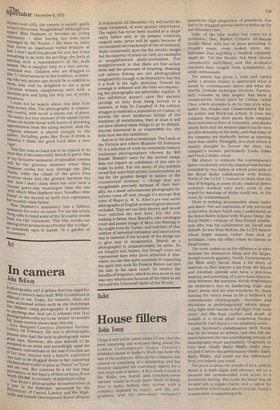Art
In camera
John McEwen
Is Photography art? A debate that has raged for almost a century and a half. Why it continues is difficult to see. Today, for instance, there are even acclaimed artists such as the Dutchman
an Dibbets, using photography in preference to
anYthing else. And yet it remains true that i.otographers who try to be 'artists' invariably all. Some current shows bear this out. GJII„lia Margaret Cameron (National Portrait a"erY till February 29) was a photographic Pioneer who had the luck to photograph some great men. However, she also wanted to be accepted as an artist and accordingly aped the academic conventions of the mid-Victorian art of her time. Anyone with a beatific expression c‘vi,a.s sure to be dragged down to her converted mckert-shed studio to pose as 'Peace' or 'Love' and the rest. But cameras lie a lot less than portraitists, so her legacy of famous faces,ff not worth E52,000, is certainly of historical value. , Gus Wylie's photographic documentation of "_ Year in the Hebrides, sponsored by the. rolytechnic of Central London and the Highands and Islands Development Board (Regent
St Polytechnic till December 13), will surely be, when completed, of even greater importance.
The region has never been studied as a single entity before and, in its present relatively unspoilt state, never will be again because of the imminent encroachment of the oil industry. Wylie occasionally goes for the artistic image, but the majority of prints on view are examples of straightforward photo-journalism. Too straightforward, in that there are few action shots and the processes of weaving, shearing and salmon fishing are not photographed imaginatively enough to be instructive, but this is a fault in the right direction. Overall his coverage is unbiased and the tests accompanying the photographs are admirably explicit. If this exhibition doesn't save the ancient carvings on Islay from being moved to a museum, or help Dr Campbell in his solitary struggle to maintain a population on Canna, or prevent the more barbarous sitings of the imminent oil installations, then at least it will not have allowed these things to go by default. Anyone interested in or responsible for, the Isles must see this exhibition.
And so to the land as landscape. The Land, at the Victoria and Albert Museum till February 15, is a selection of work by twentieth-century landscape photographers chosen by Bill Brandt. Brandt's taste for the eternal image does not require an exhibition of this size to make its point. Far too many of the exhibits reveal that same fatal artistic consciousness, an eye for the graphic design in nature or the monumental moment — things that are recognisable precisely because of their banality. As a result informational photographs for surveys come off well, though it's strange that some of Major G. W. G. Allen's pre-war aerial photographs of English archaeological sites are excluded. They are too little known and would have matched the best here. For the rest, nothing is better than Brandt's own catalogue cover and poster image of Skye, too fleeting to be caught even by Turner, and redolent of that mixture of universal metaphor and association that is essential if the bounds of the image are to give way to imagination. Brandt as a photographer is unquestionably an artist. So are Stieglitz and Adams, but though some are represented here who have achieved it elsewhere, no one else quite succeeds in capturing the spirit that took Sir Francis Bacon out into the rain in his open coach `to receive the benefits of Irrigation, which he was wont to say was very wholesome because of the Nitre in the Aire and the Universal! Spirit of the World.'

































 Previous page
Previous page